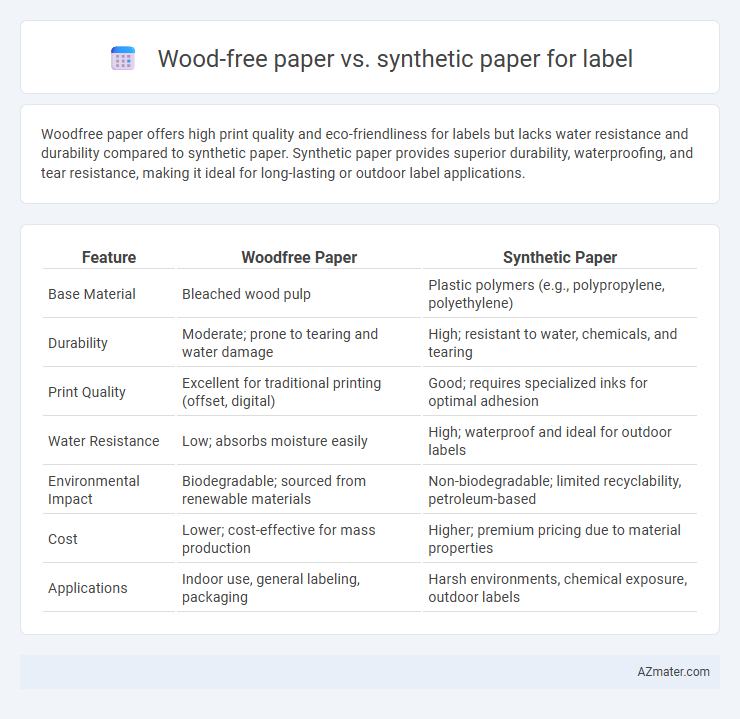Woodfree paper offers high print quality and eco-friendliness for labels but lacks water resistance and durability compared to synthetic paper. Synthetic paper provides superior durability, waterproofing, and tear resistance, making it ideal for long-lasting or outdoor label applications.
Table of Comparison
| Feature | Woodfree Paper | Synthetic Paper |
|---|---|---|
| Base Material | Bleached wood pulp | Plastic polymers (e.g., polypropylene, polyethylene) |
| Durability | Moderate; prone to tearing and water damage | High; resistant to water, chemicals, and tearing |
| Print Quality | Excellent for traditional printing (offset, digital) | Good; requires specialized inks for optimal adhesion |
| Water Resistance | Low; absorbs moisture easily | High; waterproof and ideal for outdoor labels |
| Environmental Impact | Biodegradable; sourced from renewable materials | Non-biodegradable; limited recyclability, petroleum-based |
| Cost | Lower; cost-effective for mass production | Higher; premium pricing due to material properties |
| Applications | Indoor use, general labeling, packaging | Harsh environments, chemical exposure, outdoor labels |
Introduction to Woodfree and Synthetic Papers
Woodfree paper, primarily composed of chemical pulp, offers high brightness, smoothness, and excellent printability, making it ideal for high-quality labels requiring clear, sharp images. Synthetic paper, made from polypropylene or polyethylene, provides superior durability, water resistance, and tear resistance, well-suited for labels exposed to harsh environmental conditions. Both materials serve distinct labeling needs, with woodfree paper favored for indoor applications and synthetic paper for outdoor or wear-resistant labels.
Composition and Manufacturing Process
Woodfree paper consists primarily of cellulose fibers derived from wood pulp, processed to remove lignin and impurities for a smooth, bright surface ideal for high-quality printing. Synthetic paper is made from plastic resins such as polypropylene or polyethylene, produced through extrusion and calendaring to create a durable, water-resistant material. The manufacturing process for woodfree paper involves chemical pulping and bleaching, whereas synthetic paper relies on polymer extrusion, resulting in significantly different physical properties and end-use applications.
Print Quality Comparison
Woodfree paper offers excellent print quality with high brightness and smooth surface, providing sharp images and vibrant colors ideal for detailed label designs. Synthetic paper excels in print durability and resistance to water, chemicals, and tearing, maintaining print clarity even under harsh conditions, making it suitable for labels exposed to moisture or abrasion. Both materials support high-resolution printing, but synthetic paper's resilience ensures long-lasting print quality where durability is crucial.
Durability and Resistance Features
Woodfree paper labels offer smooth printing surfaces but exhibit limited durability and lower resistance to moisture, chemicals, and tearing, making them less suitable for harsh environments. Synthetic paper labels, made from durable polymers like polypropylene or polyethylene, provide superior resistance to water, oils, chemicals, and abrasion, ensuring long-lasting label legibility and integrity. These resistance features make synthetic paper the preferred choice for applications requiring enhanced durability and exposure to outdoor or industrial conditions.
Environmental Impact and Sustainability
Woodfree paper for labels is derived from cellulose fibers without mechanical pulp, resulting in a cleaner, brighter material with less lignin content, making it more biodegradable and recyclable. Synthetic paper, made from polypropylene or polyethylene, offers superior durability and water resistance but poses challenges in recycling due to its plastic composition, often requiring specialized facilities. Choosing woodfree paper supports reduced environmental impact through biodegradability and easier integration into waste streams, while synthetic paper's longevity can reduce label replacement frequency, potentially lowering overall material consumption.
Cost Analysis: Woodfree vs Synthetic
Woodfree paper generally offers lower initial costs compared to synthetic paper, making it a budget-friendly option for label printing. Synthetic paper, while more expensive upfront, provides enhanced durability, water resistance, and tear resistance, potentially reducing long-term replacement and maintenance expenses. Businesses must weigh the immediate savings of woodfree paper against the longevity and performance benefits of synthetic paper in cost-effectiveness evaluations.
Application Suitability for Labels
Woodfree paper offers excellent print quality and is highly suitable for indoor labels requiring smooth, writable surfaces and cost efficiency, especially in packaging and retail environments. Synthetic paper excels in durability, moisture resistance, and tear-proof properties, making it ideal for outdoor labels, industrial applications, and products exposed to harsh conditions. Choosing between woodfree and synthetic paper depends on factors like exposure to elements, label lifespan, and required print clarity for the specific labeling application.
Adhesive Compatibility and Performance
Woodfree paper demonstrates excellent adhesive compatibility with pressure-sensitive and water-based adhesives, ensuring strong label adhesion on various surfaces, but may suffer in moisture resistance and durability. Synthetic paper offers superior adhesive performance due to its smooth, non-porous surface, enhancing bonding with aggressive adhesives like acrylic and hot melts, while maintaining superior resistance to water, chemicals, and abrasion. Selecting between woodfree and synthetic paper for labels depends on the specific adhesive used and the environmental conditions the label will face, with synthetic paper excelling in demanding applications requiring lasting adhesion and durability.
Aesthetic Options and Customization
Woodfree paper offers a smooth, matte finish ideal for high-resolution printing and rich color reproduction, making it a popular choice for elegant, classic labels. Synthetic paper provides superior durability with water, tear, and chemical resistance, available in a variety of textures and finishes including glossy, matte, and satin, enabling extensive customization options for vibrant and long-lasting labels. Both materials support advanced printing techniques such as digital and flexographic, but synthetic paper's flexibility in design and resilience makes it preferable for labels exposed to harsh environments or requiring unique shapes and textures.
Choosing the Right Paper for Your Labels
Woodfree paper offers excellent print quality and cost-effectiveness for general label applications, making it suitable for indoor use where durability is less critical. Synthetic paper provides superior water resistance, tear resistance, and durability, ideal for labels exposed to moisture, chemicals, or outdoor environments. Choosing the right paper depends on the label's intended use, environmental exposure, and budget constraints to ensure optimal performance and longevity.

Infographic: Woodfree paper vs Synthetic paper for Label
 azmater.com
azmater.com